 In the fight against the growing obesity epidemic, sugar-sweetened beverages (SSBs) have emerged as a major enemy. Most people know that soda isn’t the most nutritious choice of beverage, but juice retains an image of healthfulness – after all, it originates from fruit and can be a good source of certain vitamins when consumed in moderation. The problem is that many beverages thought of as “juice” actually contain very little fruit-derived content and lots of added sugars. And while 100% juice drinks may add some vitamins to the diet, they can also contribute to excessive sugar intake, resulting in problems such as tooth decay and obesity. Juice is traditionally thought of as an appropriate beverage to provide to children as an alternative to milk or water. There is something so cute about a baby sipping from a cup of juice, and its sweet flavor is likely to be readily accepted by most children. However, guidelines from the American Academy of Pediatrics recommend that caregivers avoid offering juice to infants younger than 6 months and limit intake after that, stating that “for children older than 6 months, fruit juice offers no nutritional benefits over whole fruits”. Children who get their fruit servings from juice also miss out on the filling fiber contained in whole fruits. Further, new research suggests that children who were given juice at an early age drink more soda and other SSBs and have a higher BMI at later ages that children who were not introduced to juice until they were older.
In a recent study of Project Viva participants, a group of investigators led by Kendrin Sonneville examined whether children’s consumption of juice and water at 1 year of age was associated with intake of juice, intake of SSBs (fruit drinks and soda), and BMI in early childhood (~3 years) and mid-childhood (~8 years). The investigators aimed to determine whether juice may act as a “gateway drink”, with higher intake by young children establishing preferences for sweet beverages in later childhood. Their results supported this hypothesis; children who were given juice at 1 year of age drank more juice and SSBs in early and mid-childhood than children who did not drink any juice at 1 year. Juice intake at 1 year was also associated with BMI in both early and mid-childhood, but not with weight-for-length at 1 year. This suggests that even if early juice introduction does not result in immediate gains in adiposity, it may establish a pattern of increasing inclusion of SSBs in the child’s diet. Since SSB intake is associated with increased weight gain in both children and adults, early programming of a preference for sweet beverages can have a lasting impact on weight status. As my baby approaches the 6-month mark and I plan for his introduction to sources of calories other than breast milk, studies such as this one give me even more to think about. Based on his reaction to the sugar-sweetened vitamin D drops provided by my pediatrician’s office, I suspect that offering juice would be a reliable way to elicit a rewarding smile. However, in deciding when to introduce juice into his diet, I’ll certainly consider this evidence that I may be programming his future taste preferences to favor obesogenic sugary products.
0 Comments
Your comment will be posted after it is approved.
Leave a Reply. |
©2017 WeighingInBlog. All rights reserved. 401 Park Drive, Boston, MA




 RSS Feed
RSS Feed

